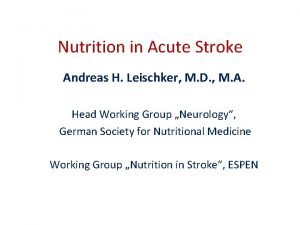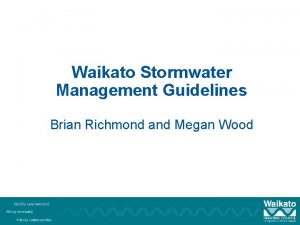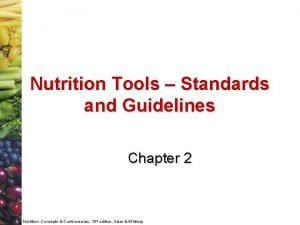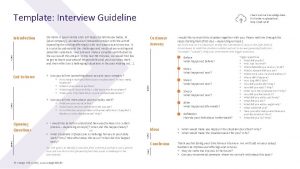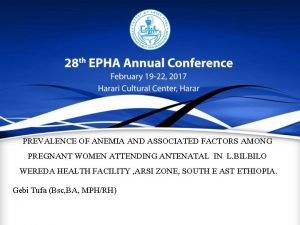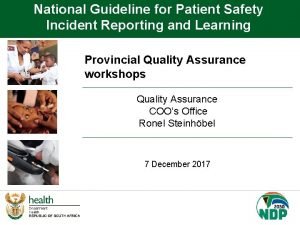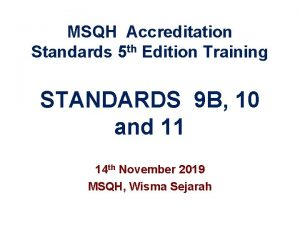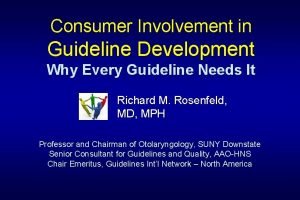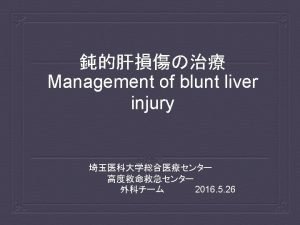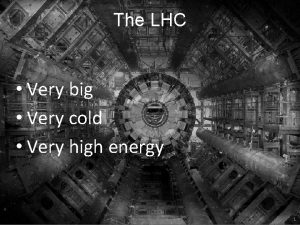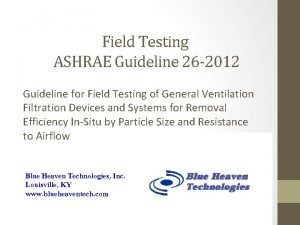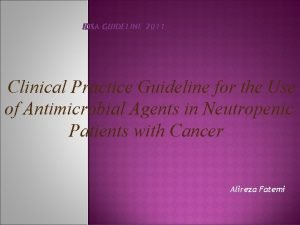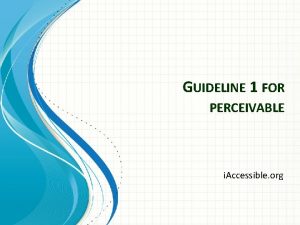Nutrition Management Guidelines Nutrition Guideline Development Process Very















- Slides: 15

Nutrition Management Guidelines Nutrition Guideline Development Process Very Long Chain Acyl-Co. A Dehydrogenase Deficiency (VLCAD)

Nutrition Management Guidelines The mission of GMDI is to provide standards of excellence and leadership in nutrition therapy for genetic metabolic disorders through clinical practice, education, advocacy, and research.

Nutrition Management Guidelines Project Organization HRSA Southeast Regional Genetics Network (SERN) National Advisory Board SERN Project Staff Genetic Metabolic Dietitians International (GMDI) Adrya Stembridge, Yetsa Osara, Katie Coakley -Content Expertise Project Staff and Funding Rani H. Singh, PI Pat Splett Dianne Frazier Core Group Workgroups Consultants Adrya Stembridge IT and Portal Librarian Fran Rohr, Co-PI Chair: Dianne Frazier Amino Acidopathies MSUD Chairs: Amy Cunningham Shideh Mofidi PKU Chairs: Keiko Ueda Elaina Jurecki Chairs: Sandy Van Calcar Mary Sowa Organic Acidopathies PROP Fatty Acid Oxidation Disorders Chair: Rani Singh Urea Cycle Disorders (future)

Nutrition Management Guidelines Nutrition Guideline Development Process Evidence /Consensus Analysis • Systematic Review of published literature and “gray literature” Delphi Process – Round 1 • Survey of expert practioners– MDs and RDs HRSA Genetics Regions Workgroup Evidence Summary and Preliminary Recommendations • Recommendations for nutrition management based on literature review • Identification of variations in practice based on Delphi survey Nominal Group Technique • Face-to-Face meeting of expert panel • Discuss areas of practice variation, vote, discuss recommendations, vote again Delphi Process - Round 2 • Survey of recommendations and variations in practice identified by Nominal Group Technique panel Writing Nutrition Guidelines - Workgroups • Recommendations for nutrition management • Documentation of areas of consensus and non-consensus Review Process • External Review and Field Testing

Nutrition Management Guidelines VLCAD Guidelines Workgroup • People Involved – Core Group: 10 – Quality Criteria Analysts: 10 – Workgroup Evidence Analysts: 16 – Delphi Survey Respondents: 17 – Nominal Group Experts: 9

Nutrition Management Guidelines VLCAD by the Numbers • • • Research Questions 6 Literature search articles: 951 Formal literature included: 93 Gray literature included: 26 Formal literature excluded: 858 Animal or in-vitro study Not published in English language Unrelated to VLCAD treatment or outcomes Genetic studies not related to phenotype General overview article intended to educate those not familiar with VLCAD – Published prior to 1990 – – –

Nutrition Management Guidelines Guideline Template • Background – – – • Biochemical Basis – – • • Healthy Ilnesss Supplements Exercise Pregnancy Education – – Patient Goals Patient Resource – Provider Resources Monitoring and Evaluation – – – • • Common Diagnoses using NCP language Nutrition Management – – – • Signs and Symptoms Laboratory Findings Nutrition Problem Identification – • Rationale for treatment Biochemical pathway Nutrition Assessment – – • Definition Incidence Pre-symptomatic detection Genetics Confirmatory testing Biomarkers to follow Health benefits Harms (side effects, risks) Barriers to Implementation References

Nutrition Management Guidelines Expected Products • Guidelines – Evidence and consensus based recommendations for nutrition management • Toolkit – Case study-based practical approach with resources • FAQ Sheet/Guideline Summary – For parents • Publication – Peer-reviewed journal

Nutrition Management Guidelines

Nutrition Management Guidelines Mild VLCAD • Infants have mildly to moderately elevated concentrations of long chain acylcarnitines on newborn screening. • Diagnostic testing should confirm the diagnosis, although the plasma acylcarnitine profile may be near normal. • Individuals remain asymptomatic beyond infancy and tolerate various stressors without clinical symptoms typically associated with metabolic decompensation. • Metabolic labs may be normal when the individual is healthy. • Individuals may present during adolescence or adulthood with intermittent rhabdomyolysis, muscle pain and/or exercise intolerance, but it is unknown during infancy and childhood if the late myopathic presentation will occur later in life.

Nutrition Management Guidelines Moderate VLCAD • Infants have mildly to moderately elevated concentrations of long chain acylcarnitines on newborn screening. • Diagnostic testing, including an abnormal plasma acylcarnitine profile, should confirm the diagnosis. • Individuals are asymptomatic at diagnosis, but may experience, or are considered at high risk for, episodes of hypoketotic hypoglycemia or rhabdomyolysis with stressors such as illness, fasting or exercise. • Metabolic labs remain abnormal even when patient is healthy. However, cardiomyopathy or other cardiac presentation is considered unlikely.

Nutrition Management Guidelines Severe VLCAD • Infants have significantly elevated concentrations of long chain acylcarnitines on newborn screening. • Diagnostic testing, including an abnormal plasma acylcarnitine profile, should confirm the diagnosis. • Individuals may be symptomatic at diagnosis or within the first months of life. • The clinical picture may include hypertrophic or dilated cardiomyopathy, pericardial effusion and arrythmias, as well as hypotonia, hepatomegaly, intermittent hypoglycemia and rhabodomyolysis.

Nutrition Management Guidelines VLCAD Classifications Severe Moderate Mild Asymptomatic (Q 1) Q 4 Monitoring Illness /Symptomatic (Q 2) Pregnancy Q 7 Cardiomyopathy Rh ab do Q. 5 Q 3 Supplements Exercise

Nutrition Management Guidelines VLCAD Research Questions 1. For healthy individuals with VLCAD, what nutrient intake goals are associated with positive outcomes? 2. For the individual with VLCAD what nutrition interventions are associated with positive outcomes during illness( including cardiomyopathyor rhabdomyolsis), surgery or other stress? 3. For individuals with VLCAD, do other specific nutrient supplementation or other treatment modalities (i. e. L-carnitine, triheptanoin, bezafibrates) improve outcomes? 4. For individuals with VLCAD, monitoring of which parameters is associated with positive outcomes? 5. For the individual with VLCAD what nutrition interventions are associated with positive outcomes during exercise? 6. For the woman with VLCAD, what nutrition interventions are associated with positive outcomes during menstruation, pregnancy, delivery and the post-partum period?

Nutrition Management Guidelines Ex: Question 1 - Topics • For healthy individuals with VLCAD, what nutrient intake goals are associated with positive outcomes. – Diet composition based on severity • Fat composition • Macronutrients – Breastfeeding – Essential fatty acids – Cornstarch/night time snack/night drip feedings
 Andreas leischker
Andreas leischker Waikato stormwater management guideline
Waikato stormwater management guideline Very bad to very good scale
Very bad to very good scale Scientific notation rules
Scientific notation rules Fewfewfewf
Fewfewfewf Is a very shallow skillet with very short sloping sides
Is a very shallow skillet with very short sloping sides Quantifiers of food
Quantifiers of food Healthypeopleenergy
Healthypeopleenergy Nutrition tools standards and guidelines
Nutrition tools standards and guidelines A natural physical drive that prevents starvation
A natural physical drive that prevents starvation Interview guideline template
Interview guideline template Anemia in pregnancy guideline
Anemia in pregnancy guideline Guideline anamnesa
Guideline anamnesa Patient safety incident policy
Patient safety incident policy Msqh standard
Msqh standard Anamnesa psikologi adalah
Anamnesa psikologi adalah
